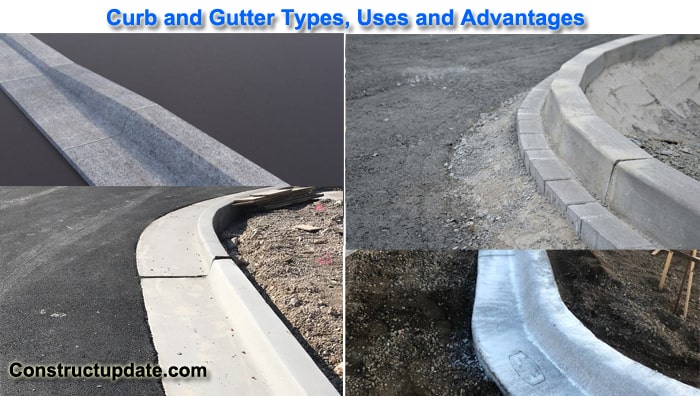What are Curb and Gutter?
Curb is a short wall that acts as a barrier between the yard and the street, holding the pavement in place from the sides. It is bordered on one side by a gutter, which is a flat concrete surface that drains water from the yard. Curb and gutter are usually built at the same time on a job site.
Curbs and gutters of various varieties are utilised in the building of light and heavy road pavements. Along the length of the road, the curb and gutter are installed. The primary goal of installing a curb and gutter is to strengthen the road’s surface.
Read this article to know more about different types of curb and gutters, applications, construction process, advantages, and disadvantages.
Types of Curb and Gutter:
- Mower Curb and Gutter:
Mower curbs are commonly found in gardens and settings where flowery lawns are maintained. The curbs and gutters on this sort of walkway have a decorative appearance and offer a sturdy and protective barrier between the walkway and the green zone.
- Mountable Curbs and gutter:
Mountable curbs have a modest incline on one side of the curb to make it easier for vehicles to pass over them. These types of curbs are ideal at intersections where pedestrians with shopping carts or strollers, as well as those on bicycles or roller skates, need to cross the sidewalk securely.
- Monolithic Curbs:
Monolithic curbs are built or fused with the road, and the top levels are matched to increase traction and allow heavier cars to pass without destroying the asphalt or concrete’s interior structure or foundation.
- Slanted Curb and Gutter:
Slanted curbs serve no practical use, but they do add to the aesthetic appeal of the area.
These are merely decorative and decorative courses.
- Slanted Curb and Gutter:
Slanted curbs are usually decorative curbs that are erected to draw more attention to the structure. Slanted curbs serve no practical purpose; they are solely for aesthetic purposes. They are primarily used for decoration.
Construction Process of Curb and Gutter:
- Marking and Excavation:
The first and most crucial element of any building project is marking; marking powder is applied to the manner the hook and drain will be erected.
The necessary shields are installed to ensure that all of the water on it flows efficiently; the defined area is then manually or mechanically excavated to a depth of 300 mm.
The base of the gravel mixed with cement is laid down and compacted, and all loose soil and dirt is firmly filled using human manipulation or a mechanical compactor.
The gravel base for both the curb and gutter is laid at the same time, and the junction width is determined by the width of the gravel base.
- Formwork:
Plywood or steel moulds are used to construct the formwork. The formwork design is determined by the sort of curb that will be built. Wood pegs are pushed into the ground with a hammer behind them to secure the formwork.
Metal clamps or 1-by-2 boards hammered across the tops of the curb form boards around every foot will keep the two boards together to retain the spacers in place. At regular intervals, spacers are given.
The formwork is plumbed and levelled to ensure proper alignment and shape. To prevent concrete from clinging to the formwork, coat it with cooking oil or a similar substance.
- Concreting:
The needed design mix of concrete should be made and poured in the formwork. The concrete must be adequately compacted, and any voids must be filled.
Remove the formwork and scooter from the curb and gutter surfaces once the concrete has cured and hardened. Concrete finishing tools should be used to adequately finish the surface of the curb and gutter.
- Curing:
Following the completion of the curb, gutter, and finishing work, the curb should be cured to provide the appropriate strength and durability. It is essential that the curb is protected from vehicles and extreme hot or cold weather.
Advantages of Curb & Gutter:
The following are some of the benefits of curb and gutter:
- The curbs help the road sweepers work more efficiently by centering the debris.
- Curbs add to the aesthetic appeal of parking lots and streets.
- Curbs also serve as a back support for the road’s pavement.
- Gutters aid in the efficient drainage of water that drips from the pavement’s surface.
- Concrete curbs feature a reflective surface that aids visibility at night and helps to prevent accidents.
- Curbs create a closed barrier that aids in the compaction of concrete during road building and helps to retain the integrity of the edges.
Disadvantages of Curb & Gutter:
- The construction process necessitates the use of trained labour.
- It raises the cost of construction.
- During the rainy season, the gutter may become clogged, resulting in excess water on the road.









